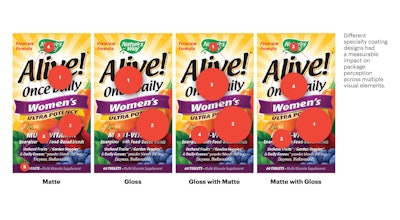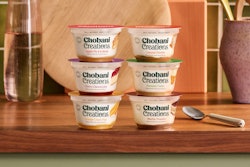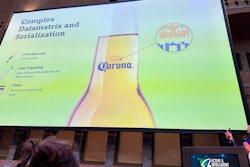
Companies in all industries seek to increase the likelihood of their products being purchased by consumers. Brand reliability and trust can take time to establish, beyond the issue of enticing consumers to take a chance on the product in the first place. Packaging structure and design are the initial contact between product and consumer and can play a large role in the ultimate choice of a consumer to put a product in their cart.
Quad, a global marketing experience company, homes in on consumer purchasing insights via a twofold system with its Package InSight and Technology teams. Quantitative data is gathered through the Package InSight team’s methodology of mobile eye tracking, facial coding, and brain activation technology. Qualitative data is gathered through traditional surveys and interviews. The two types of data combine to provide Quad’s clients with a holistic view on the success of their package designs.
Quad approached Nature’s Way, a vitamin and multivitamin producer, to participate in a study centered around specialty printing and coatings, specifically the use of matte versus gloss varnish. The study was designed to enhance brand messaging across a range of product categories, Nature’s Way filling the health and beauty category.
Design affects consumer decisions
As explained by Jennifer Hickman, Quad's head of strategy for health, the pharmaceutical industry tends to focus most on the regulatory aspect of packaging, ensuring the proper educational materials, regulatory content, and symptom relief lists are clear and visible.
And while those are very important, Hickman notes that “a well-designed package would do two things. Number one, it would play into some conscious decision-making on behalf of the consumer, as well as number two, unconscious decision making.”
On the conscious side, she says the design must reinforce the brand promise. The unconscious side requires primary research to understand what affects consumer behavior in the chosen simulated environment. Various brands of the same drug cohabit that same aisles yet some are more successful than others. In many cases, the packaging is the only difference. Companies that take a chance on new package design elements can find themselves selling out faster than the competition, according to Shannon Anderson, client research manager for Package InSight by Quad.
 | Multiple Fatalities Alleged as Nurse Swapped Fentanyl with Tap Water |
Quantitative data from eye-tracking technology
Quad gathers cohorts of a minimum 30 people, which provides a normalized data set, testing for statistical value 95% confidence, though the company can run the study at a lower rate if a client prefers. The test groups are sent into one of Quad’s two simulated store labs at its Greenville, SC location with a basic prompt, not knowing which product packaging is the focus of the study, wearing a pair of Tobii Pro Glasses 3. A one-way mirror around the retail lab allows the Package InSight team to observe real-time consumer behavior.
Eye tracking is one of Quad’s main tools for understanding consumer behavior. The Tobii glasses use embedded cameras in the lens pointing inward towards the eyes, as well as outward facing cameras. The glasses record movement at 50 times per second, which results in accuracy down to the size of a postage stamp with a minimal margin of error.
“The software takes the forward-facing camera and then overlays it with how your eyes moved. And then we take a still picture of the shelf, and code the video to that still picture. So the technology looks at the video and looks at the still picture and starts making points where the two things match your eye movement and what it sees in that picture,” says Anderson.
 The study gathers quantitative data using Tobii Pro Glasses 3 as well as qualitative data through surveys and interviews to provide holistic results.
The study gathers quantitative data using Tobii Pro Glasses 3 as well as qualitative data through surveys and interviews to provide holistic results.
As soon as the test groups exit the simulated store, they either do an online survey, or are taken aside for an in-depth interview with Anderson. At that point, the focus of the study is revealed, and the test groups are asked pointed questions to establish qualitative data. The quantitative data provides the answer to what the consumers did, and the qualitative data explains why. The surveys and interviews also help explain discrepancies in consumer behavior.
 | High Growth in 2024 Predicted for Contract Packaging Industry |
Study results
The study includes an elemental analysis which breaks down the product packaging into five design elements to determine how often and how quickly each caught consumer visual attention. The five elements are brand name–Nature’s Way, count–the number of pills as displayed on the packaging, label–product information, product name–Alive!, and visual–the fruits and vegetables graphic.
Quad tested out the matte and gloss finishes on these various elements to determine which was the most effective between:
- All-matte
- All-gloss
- Gloss with matte
- Matte with gloss
The shoppers were screened based on age, shopping habits, and whether or not they were the primary household shopper or shared shopping responsibilities as part of the qualitative data that would help the Package InSight team better understand the quantitative data gathered with the Tobii glasses.
The result determined even though the specialty coatings drove attention versus the competition thanks to the added tactile and visual dimensions, the difference in results between the tested versions were slight. However, the potential impact on sales is projected to be substantial, especially from the gloss with matte test version as it has the highest purchase count at 200% higher than the all-matte version and 50% higher than both the all-gloss and matte with gloss versions. Consumer survey feedback also indicated that the package’s artwork had a greater impact on consumer impressions of the product.
“The use of specialty coatings can be applied for any brand, not just in health and beauty, but all over the store. The trick is applying it correctly,” says Anderson. “There's lots of different ways you can use this sort of specialty coating and specialty print and the best way to find out how is through testing. Then we can really see how the visual interest turns into intent to purchase.”
 | Read this story PFAS: Navigating Materials of Concern in Life Science Packaging on paper packaging. |

























